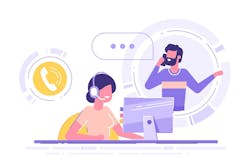Now more than ever, human connection is of the utmost value. If your shop is failing to follow up with customers, it’s like watching money walk out the door.
“There are many industries that don’t feel a need to follow up, and it’s criminal,” says Nancy Friedman, founder and chairman of the Telephone Doctor and a keynote customer service public speaker.
There may be a variety of reasons businesses don’t feel the need to follow up, she says, but there’s no excuse.
Here’s everything you need to know to circle back, to keep customers coming back.
How can you follow up?
Friedman says the best way to contact customers for a follow-up message is their preferred method. She offers six touch points for communication, but says something as simple as, “When we follow up, how would you like us to follow up?” can go a long way with customers.
“Asking how they would like to be reached shows you’re invested and it gives them a choice,” Friedman says. “Not everyone wants more emails or their phone ringing.”
Mark Probst, owner of Probst Auto Body in Detrich, Ill., uses an automated communications system to follow up with his clients, to encourage reviews and even spur referrals. Probst’s shop boasts a perfect five-star rating on CarWise and 4.9 stars on Google Reviews.
Probst says he uses Body Shop Booster, an automated communications platform. Each time a vehicle is closed out, a page prompts the customer to enter their name, phone number, and preferred contact method—email, text, or ringless voicemail.
Before automating his follow-up procedure, Probst says his shop used traditional methods like personal phone calls, handwritten letters, and printed newsletters.
The 6 Touch Points
Nancy Friedman, a keynote customer service speaker, says there are six ways to follow up with customers.
-
Face-to-face
-
Phone call
-
Email
-
Voicemail
-
Snailmail
-
Fax
When should you follow up?
At Probst Auto Body there’s a timeline for following up that lasts three years, Probst says.
A day—24 hours to be exact—after his or her vehicle has been returned, the customer receives their first phone call from the shop. Probst says the first phone call is made only to thank the customer for choosing his shop.
Two days after the vehicle has left the shop, Probst says customers receive an automated text message, directing them to an internal review system as well as the shop’s Google Reviews page, should he or she want to leave a response.
The shop then sends out a one-month ringless voicemail to make sure everything is running as it should with the vehicle and that the driver feels safe behind the wheel.
From there, Probst’s shop contacts the customer every six months to see if they need any new parts, have any questions, and most importantly, to ask for referrals.
Once those three years are up, if the shop still hasn’t made an impression, Probst says he knows he’s done all he could do.
Friedman underscores the importance of such an involved sequence of communication. She says following up with past customers is vital and can also be used to bring in new business.
Call back potential clients who only asked for an estimate, Friedman says, or even reach out to customers who used your service more than three years ago.
“See if everything is working in fine condition and see if there’s anything else you can offer them,” she says.
What’s stopping you?
The primary reason businesses fail to follow up with their customers, Friedman says, is out of fear.
“People are afraid to get a bad answer or a bad review,” she says, adding that it stops businesses from reaching out at all.
Even if there’s a less-than-positive review waiting on the other line, Friedman says the follow-up creates an opportunity to fix it. Listen to your client, empathize with their needs, and resolve his or her issue, she says.
How do you get through to your employees?
If you have an employee who is unwilling to make a follow-up call, that could be an indicator that the shop culture needs some work, Friedman says.
“If someone doesn’t know why they need to follow up, there needs to be more training,” she says.
At his shop, Probst is the first point of contact over the phone with each customer post-repair—he calls it the “CEO call.”
“It’s a way for me to connect with [customers] as an owner,” he says. “Yes, I’m busy, but I want to touch base and show I’m involved and that I care.”
After the CEO call, customers receive follow-up messages from other leaders within the shop, Probst says. A month after the initial visit, the production manager will make the call to check in with clients. For the yearly calls, a customer service representative will reach out and ask clients for an update on their vehicle and to answer any questions they may have.
What do you risk losing?
Friedman says that if your business doesn’t have a standard operating procedure for following up, you are losing potential future business each time a customer leaves your shop.
If a repair goes perfectly, Friedman recommends reaching out and seeing if those happy customers would like an updated part, a light fixed, whatever.
“You need to put ideas into the customer’s head,” she says, “nothing will happen if you don’t follow up.”
Probst says one of the most important parts of the follow-up procedure at his shop is asking for referrals.
“A customer may not be in an accident for another seven years, but if we’re touching base and constantly asking for referrals, we stay top of mind,” he says.
Even if a customer doesn’t know of anyone whose vehicle is in need of repair, Probst says asking for referrals helps to keep the shop in front of those it served in the past, “So they don’t forget about us.”
